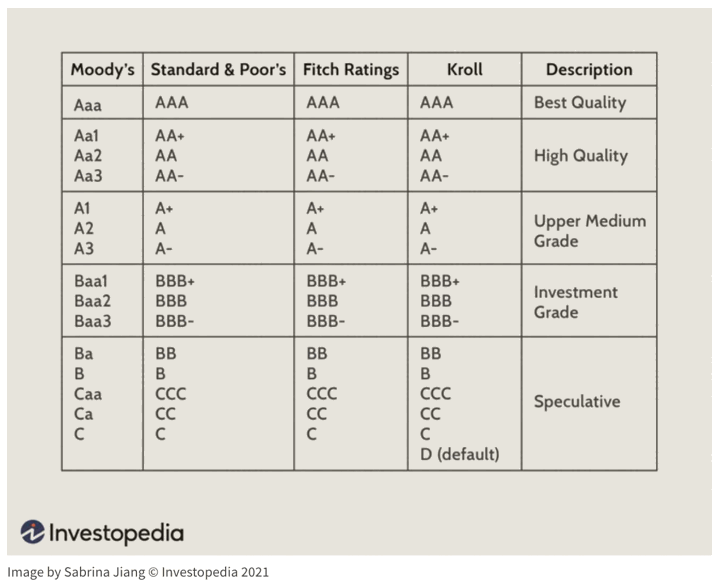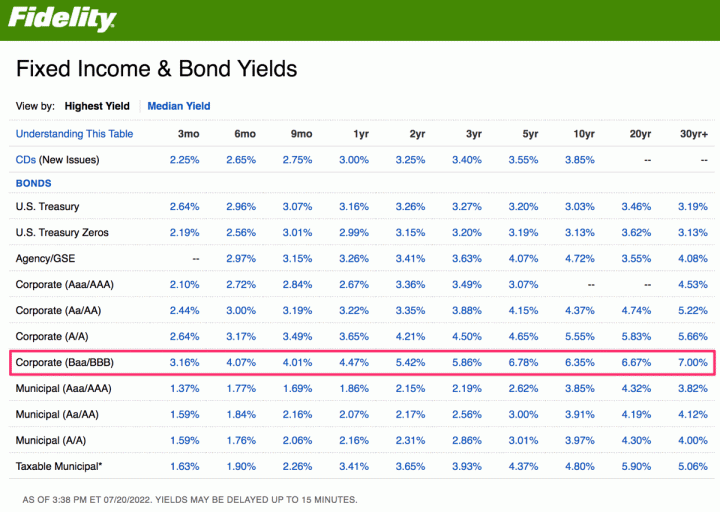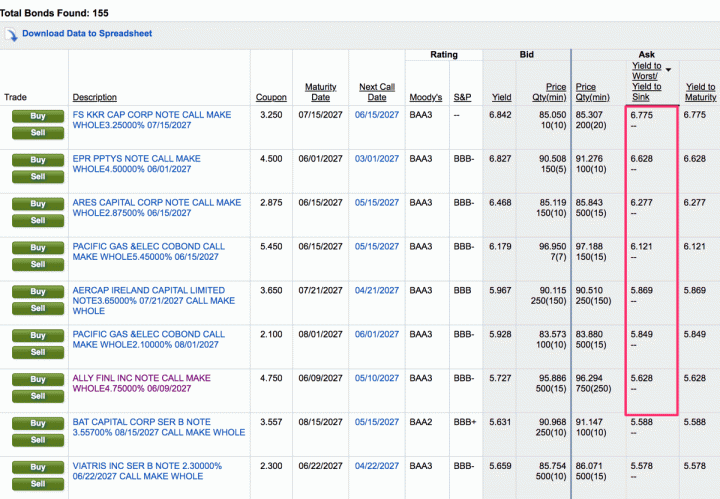Here’s a good question from reader Elizabeth in response to yesterday’s post about buying Treasury bonds on the open secondary market:
One thing I’m interested in is on that same table you shared – Corporate bonds rated BBB are around 6% for 5 years. Can you write about this? What are the pros and cons?
Here’s my thought process. Yes, us “retail” investors can also buy individual corporate bonds via major brokers with a fixed income desk like Fidelity. (Bond trading is rare on newer trading apps like Robinhood.) The bonds are judged by various rating agencies and usually separated by their grading. Right now, I see a Moody’s BAA3-rated corporate bond with 5 years left until maturity paying 6.78% interest (click to enlarge):
However, corporate bonds are not within my circle of knowledge. The special thing about every single US Treasury bond is that they are all fully-backed by the US government. Same with an FDIC-insured bank CD or NCUA-insured credit union certificate. It’s like comparing all 16 oz. jars of JIF brand peanut butter; I know all of them are the same, so I can just buy on price.
Once you venture into the world of corporate bonds, things get a lot more complicated. There is wide range of potential credit risk from the issuing company. If the company fails, you may not receive your initial principal back. There is call risk from callable bonds where the issuer can redeem your bond early (to their benefit), not to mention several other early redemption wrinkles like “make whole call”, “sinking fund protection”, and “special optional redemptions”.
Baa3 and BBB- rated bonds are still technically “investment-grade”, but they are just one notch above “below investment-grade”, aka “junk”, aka “high-yield” bonds. Here is a quick table of bond ratings from Investopedia:

If take a closer look at the available bonds above, you’ll see that only one bond is paying over 6.7% and it doesn’t even have an S&P rating, which means there might be something funny going on. The rates quickly go back down to the 5.XX% range.
Do I know why one bond has to pay 6.7% interest rate to entice a buyer, while another one only has to offer 4.8%? I must admit that I really have no idea.
Bonds are for safety. In addition, I should remember my reason for holding bonds. They are my safety blanket. They are my next 10 years of expenses that are guaranteed to be there even if bad things happens. What if Russia bombed a NATO country tomorrow? The US would be obligated to go to war. China might then feel that it has to back Russia. Who knows. Hope for the best. Prepare for the worst.
My goal with bonds is to maximize yield without sacrificing safety.
Stocks are for growth and upside potential. Let’s take the bottom bond highlighted – an Ally Financial corporate bond paying 5.6% yield for the next 5 years. Ally Bank is familiar to me, and I am a longtime customer. Why not buy that bond? Well, if I bought that bond, the most that it will ever pay me back is the bond face value and interest. Worst case is still that Ally goes bankrupt and I lose all or most of my entire investment and end up with zero. This has happened, and to much larger companies than Ally.
Up to 6 days before their eventual collapse, Lehman Brothers had an A investment grade rating. The eventual recovery on their bonds was 21 cents on the dollar.
However, I could also buy Ally Financial stock (ticker ALLY). Right now, it is trading at only a 4.72 P/E ratio and is even paying a dividend yield of 3.54%. Five years from now, I could be sitting on a +50% or +100% or +200% total return. In other words, if you want to take on risk for a higher return, you are competing with stocks. There is ongoing debate about the inclusion of high-yield bonds in a portfolio, but I prefer to take risks with stocks and keep my bonds as safe as possible.
Consider a low-cost, diversified mutual fund or ETF. The benefit of holding riskier corporate bonds inside a mutual fund/ETF is that any one corporate bankruptcy won’t wipe you out. You can be diversified across hundreds of companies. Now, you can’t control the maturity as tightly, you’ll still lose some yield to management costs, and you’re still subject to interest rate risk. If you own the Vanguard Total Bond Market ETF (BND) or any Vanguard Target Retirement Fund, you already own corporate bonds inside a fund.
If I had to buy corporate bonds and wanted a stream of higher income without a reckless amount of credit risk, I would consider the Vanguard High-Yield Corporate Fund Investor Shares (VWEHX, $3k min) or Vanguard High-Yield Corporate Fund Admiral Shares (VWEAX, $50k min). VWEHX has a 0.23% expense ratio and a 30-day SEC yield of 6.71% as of 07/18/2022. VWEAX has a 0.13% expense ratio and a 30-day SEC yield of 6.81% as of 07/18/2022.
You are buying a basket of nearly 700 bonds that straddle the line between investment-grade and below investment-grade. This is a bond fund that I would own for the income stream, not if I needed the entire amount in cash soon as it can drop quite a lot during times of market stress. The expense ratio on this Vanguard fund is much lower than the industry average. Just a suggestion for further research. I don’t own this fund. In fact, I don’t own any corporate bonds at all.
Hope that helps!


 The Best Credit Card Bonus Offers – 2025
The Best Credit Card Bonus Offers – 2025 Big List of Free Stocks from Brokerage Apps
Big List of Free Stocks from Brokerage Apps Best Interest Rates on Cash - 2025
Best Interest Rates on Cash - 2025 Free Credit Scores x 3 + Free Credit Monitoring
Free Credit Scores x 3 + Free Credit Monitoring Best No Fee 0% APR Balance Transfer Offers
Best No Fee 0% APR Balance Transfer Offers Little-Known Cellular Data Plans That Can Save Big Money
Little-Known Cellular Data Plans That Can Save Big Money How To Haggle Your Cable or Direct TV Bill
How To Haggle Your Cable or Direct TV Bill Big List of Free Consumer Data Reports (Credit, Rent, Work)
Big List of Free Consumer Data Reports (Credit, Rent, Work)
Jonathan,
Nice summary!!
I used to buy corporate and muni bonds before interest rates went down. You can buy bonds with a decent coupon but you will pay above par. When interest rates went down, all my bonds were eventually called. Currently I own only iBonds and treasuries bills through treasury direct.
I haven’t bought individual bonds and I’m not an expert on them.
I think there are some details in how they work that aren’t obvious. Like for one, I recal that some bonds can be ‘called’ which means the company that issued the bond can buy back the bond for principal. (I think) So that could be a potential wrinkle to look at. If a company has some bonds that are currently paying hither % rates then they might call them and refinance their debt. That would pull the rug out of your investment plan.
I like the fact that if you buy a bond at a particular yield and hold it to maturity, your total return on that investment will be equal to the yield (ignoring reinvestment risk of the coupons for the moment). But I’m with you–I’m not comfortable evaluating individual credits. One shortcoming of owning a bond fund is they tend to maintain a fixed average maturity to match whatever their benchmark is, so they generally don’t hold bonds to maturity. Instead they swap them out for longer-dated bonds as time goes by. That means if you invest in this kind of bond fund your total return can deviate significantly from your going-in yield.
One tool I’ve added to my arsenal is “Bullet Shares” or “iBonds” (which are different from the Savings Bonds) from Invesco and iShares respectively. These are low-cost (10 basis points) ETFs that hold a portfolio of bonds that all mature in the same calendar year. The ETF buys bonds, distributes income monthly, and holds them to maturity. In the target/maturity year the ETF liquidates and distributes all proceeds to the shareholders.
They come in four different flavors, for example all Treasuries, all Munis, all Investment-Grade Corporates, and all High Yield. There are series that mature each calendar year pretty far out into the future. I’ve found these ETFs to be a low-cost way to gain exposure to a bond index–meaning I get diversification–but with the nice feature of a fixed maturity date so you can hold to maturity. And you can invest small dollars and use them to construct a ladder that is diversified by security and/or issuer while deciding how much credit risk you’d like to take.
This part is not really true:
Well, if I bought that bond, the most that it will ever pay me back is the bond face value and interest.
I buy longer duration corporate bonds. Then look for appreciation in the last 1-5 years to trigger a sell. The I get the interest and the increase in value.
The risk for a bond is that the company stays in business – true. The risk of a stock is that the company continues to make money every quarter. That evaluation is easier for me.
I just bought a few 1 year treasuries at 3%. So $3,000 nets me less than $100. So my question is – why bother? There is no chance to make decent money there.
Fixed income is 3-4x the size of the equity market. That is not because they are a bad deal.
It is just a matter of comfort.
True, it should be “Well, if I bought that bond and held it to maturity“. I almost always hold it to maturity. I don’t actively monitor the prices of my bonds after purchase, I just treat them like bank CDs.
It isn’t that difficult to check them 1-5 years before they mature. That is part of the magic of what Bill Gross did.
For my stuff, I check every few months. I look for what the effective rate on return left is. There is a trace database that TDA links to. If a bond is selling at 1.08, and the coupon was 6%, then two years out you are basically only getting 2% if you keep it. You’d get 12% if you kept it. But you can take 8% now. Plus you get to redeploy the money, so there is some extra compounding.
I get it that most people don’t want to bother. I’d say anyone that buys individual stocks could easily do well in individual bonds as well.